Godiva Clock
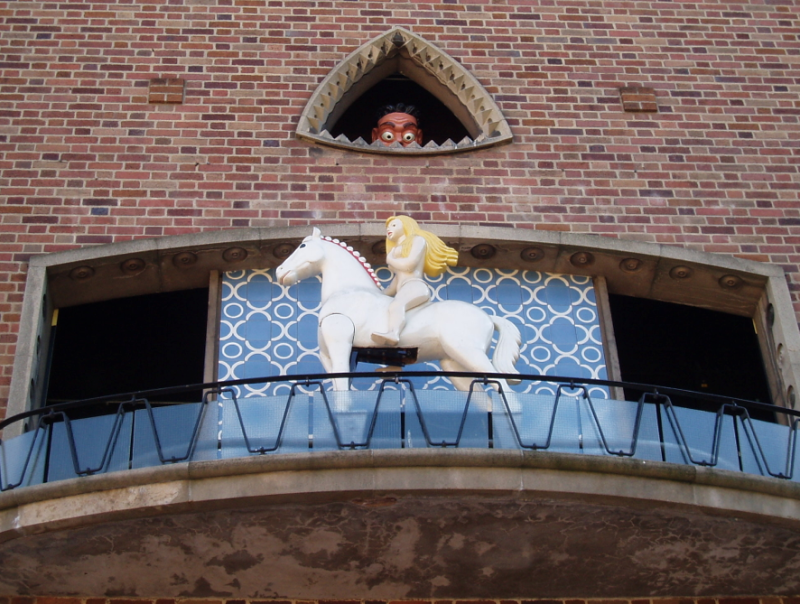
The Godiva Clock

One of the most noticeable features of Broadgate is the clock on the south side of the square. Below the clock face is a mechanical feature that has fairground like characteristics. On the hour the bell strikes, the doors open and from the right hand door comes a figure of Lady Godiva riding a white horse. She travels a short distance and goes through the other door out of sight. While this is happening above is another window that also opens and out pops the head of Peeping Tom. He has a quick look then covers his eyes as it is said he was struck blind, and quickly pops his head back in. All the doors then close for another hour. Broadgate House and the Bridge was the first post-war building the City Council completed. The City Architect, Donald Gibson, played a big part in getting this building built and he wanted artwork to be incorporated into all parts of it.
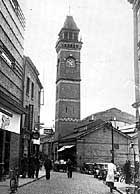
The clock itself originated in Coventry’s old Market Hall Clock Tower. The tower became unsafe after the bombing in the War and its Edward Thomas Loseby clock mechanism and bell were dismantled and incorporated into the new Broadgate clock in 1953.
Edward Thomas Loseby was a well-known Victorian clock and watchmaker. He was born in Leicester in 1817 and was apprenticed to Rotherham’s in Coventry from 1831 to 1838. In 1870, he designed Coventry’s Market Hall clock. In the contract for the clock, he had agreed to forfeit £1 for every second it varied each day, but although the clock eventually cost twice the original estimate of £308, Loseby never had to pay a forfeit. Trials in 1888 showed it to be accurate to within 0.2 second, making it far superior to the rival Westminster clock. Its time was set by a Greenwich time signal supplied by Rotherham’s, who provided this service in the 1870s and 1880s.
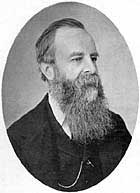
The mechanism and tracks for Godiva’s horse and Peeping Tom were designed and made by City Apprentices from the local college with the aid of Donald Gibson, who had seen a neighbour’s son playing with a mechanical toy which when pulled along the horse looked like it was galloping. This was due to the wheels having a crank shaft that made the horse bob up and down, backwards and forwards. The Lady Godiva, her horse, and Peeping Tom were carved from wood by Trevor Tennant a sculptor who was working on other projects in the city. The doors which Godiva comes out of have the symbol of the Earl of Leofric on them, a black eagle on a yellow background. He was the reason Lady Godiva rode her horse through Coventry “without any clothes”. It was to save Coventry citizens from her husbands crippling taxes. Like all good myths it has some elements of truth in it; Lady Godiva and the Earl of Leofric were real people and the rulers of this area. Godiva did many kind deeds for the citizens of Coventry, such as founding St. Mary’s Priory, but riding naked was not likely. It was more likely she had no fancy clothes of office to show how important she was. The Peeping Tom naughty tailor’s character was added much later to the myth.
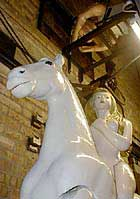

Not everyone liked the clock when it was first shown. The sculptor Trevor Tennant carved the Godiva figure and horse from wood which some found to be rather crude. However tourists and especially children have always enjoyed them.
Unfortunately the workings of the horse were damaged in the excitement of Coventry winning the F.A. Cup in 1987. The winning team returned to Coventry in an open top bus that was driven through the city and people climbed onto anything they could to get a good view. The Godiva platform was an ideal place to stand, but the horse would come out and swipe people to one side. The mechanism was blocked and badly damaged. When it was repaired the crank was taken out so it now looks like the horse glides along and it stops in the middle for photographs before moving off and back into the building.
In 1998 there were plans to change and replace the sculptured figures with a more modern design for the Millennium and a new millennium clock. But many Coventry Citizens objected and there was considerable opposition express in the local Coventry Telegraph paper. Even Pat Day, keeper of Visual Arts at the Herbert Art Gallery said – “I am of the opinion that this work is the only twentieth century masterpiece of sculpture yet created on the subject”.
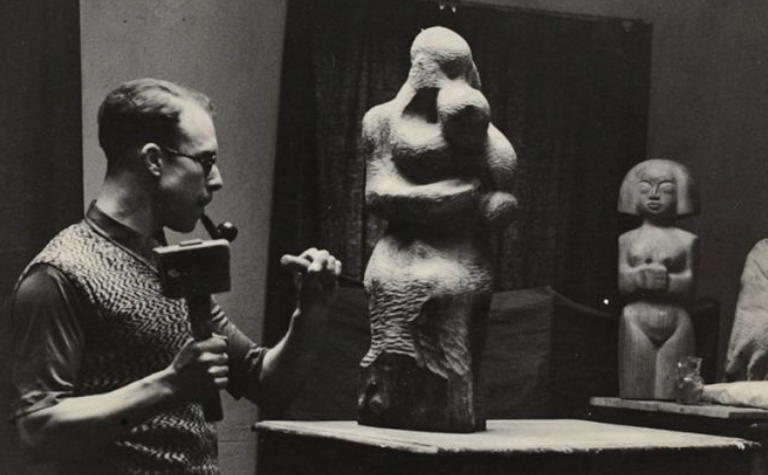
The artist (Dudley) Trevor Tennant was born in London, on 2nd July 1900, He trained at Goldsmith’s College of Art at the Royal Academy. He exhibited twice at the Royal Academy and was a Member of the Artists International Association. He taught at Camberwell School of Art, (1930-4), Dulwich College (1934-40), Hammersmith (1946-53) and Guildford School of Art.
He exhibited 19 works of art at an exhibition in 1938, which was reviewed in the Times: “Mr. Tennant is open to influences, and both Mr. Epstein and Mr. Moore are reflected here and there, but he has a way of his own which is all the more persuasive by the absence of any attempt to be “different”. He is primarily a carver and the most successful piece is “Madonna and Child'” carved in Elm wood.”
Trevor did a lot of other works of art in Coventry besides the Lady Godiva clock. His works include the Levelling Stone in the city precinct, 1946, the People of Coventry (4 works of art) on the Hertford Street side of the Broadgate Bridge, 1953, and a Falcon Relief and a Coventry Coat of Arms for Manor Park Primary School, 1950.

Trevor’s father was Charles Dudley Tennant a successful painter and commercial artist, who did illustrations for magazines and books. Trevor did not use his first name Dudley because his father used it all the time and he did not want to be mistaken for his father. The family had moved to London to be closer to the different publishers and magazines he worked for, including The Girl’s Friend, The Graphic, The Idler Penny Pictorial Magazine, The Royal Magazine, The Windsor Magazine and many more. His father died in 1952 aged 86.
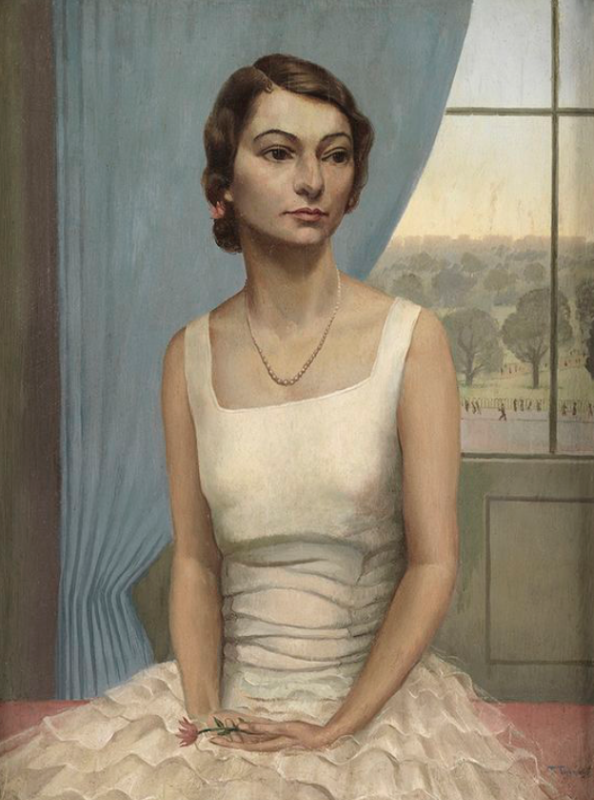
Trevor’s portrait of his wife Dorothy Annan.
Trevor Tennant’s wife was Dorothy Annan. She was born in January 1900, in Para, Brazil, to British parents and was educated in France and Germany. She became a famous artist in her own right. She did many ceramic tile designs but unfortunately many have been destroyed over the years. One large work was a series of murals done for the largest telephone exchange in London, Fleet House, 70 Farringdon Street in 1961. She was paid £300 per panel, in 1960, and there are nine in total. In 2011 the building’s new owner, Goldman Sachs,was going to be pull it down. However there were many objections because of the interesting tiles. The City of London Corporation agreed to take ownership of the murals and in 2013 they were moved to a walkway by the Barbican Centre. She has a painting of Leamington Spa’s ‘The Parade’ in the Herbert Art Gallery collection.
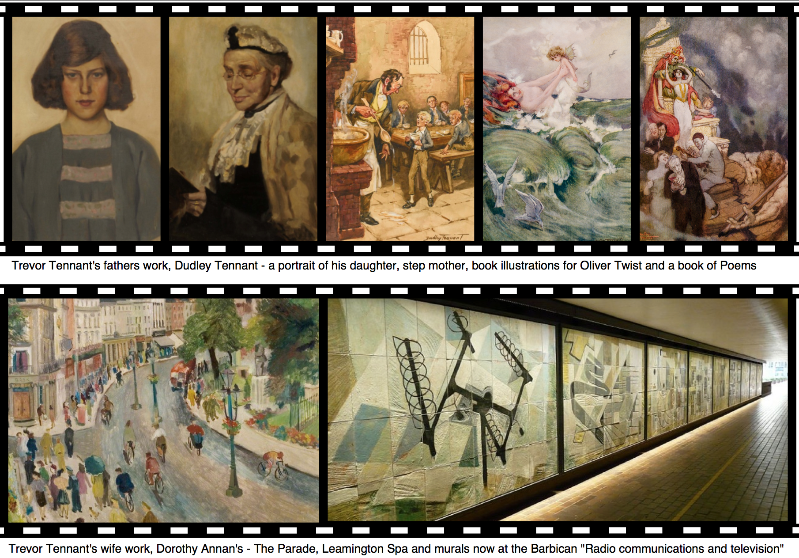
Trevor Tennant died in King’s Lynn, Norfolk, in 1980, aged 80 and his wife died in Snettisham, Norfolk, in 1983, aged 83.
